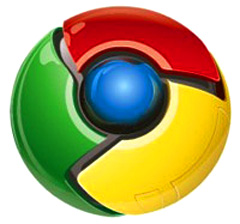
When I first heard that Google Chrome had been developed, I was sceptical. The web browser market is already dominated by Microsoft with its encumbent Internet Explorer, currently at 67%, Mozilla Firefox is steadily gaining its share, currently at around 22%, with other browsers such as Opera and Safari making up the remainder. So the obvious question is why?
Apparently, for Google, it was a purely pratical consideration. The clever developer guys at Google are creating more and more user friendly gadgets, widgets and user-interface tools to make the web easier and more fun to use and therefore more appealing to us (Google makes its money from people using the Internet!). They’re also attempting to corner the market in what’s known as Cloud Computing. This is where applications such as word processors, spreadsheets and presentation software run on Google servers instead of on your computer which works in a similar way to web based email, Facebook, YouTube, etc. Google Documents is a popular example of Cloud Computing.
Existing web browsers just can’t cut the mustard
All these gadgets, widgets, and user-interface tools, which are necessary for Cloud Computing, run on a web browser based scripting language called Javascript. Compared to Flash, Javascript isn’t a particularly fast or efficient language and the problem is that if you have a lot of Javascript running in browsers such as Internet Explorer and Firefox, it tends to slow things down quite dramatically and can even cause your browser to crash. Also, with Javascript becoming more and more common on websites, the likelihood of those particularly annoying situations where you’ve just spent half an hour or more carefully writing an email, report or article and suddenly your browser crashes and you’ve completely lost all your hard work. Generally, it’s best practice to write in a desktop based text editor and copy and paste afterwards.
Google Chrome to the rescue
This is where Google Chrome comes in. It was developed with running lots of Javascript in mind and optimised specifically for that purpose. In fact, Google claims that Chrome is around 56 times faster than Internet Explorer! It also addresses a number of issues related to stability and security rather elegantly and, in my opinion, is a far superior web browser to Microsoft’s Internet Explorer 7 and 8. For example, browser tabs in Google Chrome run independently so if a web page on one tab causes it to crash, other tabs are not affected. Google also keeps track of known Phishing and Malware websites and Google Chrome will warn you if you attempt to navigate to one of these sites on their blacklist. However, this doesn’t include unknown Phishing and Malware websites and if you’re really security conscious and would also like to block all those annoying flashing banner ads, I’d recommend using Mozilla Firefox with the NoScript plugin.
Criticisms
Ultimately, however, even in a superfast browser with all the bells and whistles, Javascript is a slow and inefficient language when compared to Adobe Flash, Microsoft Silverlight and Sun Systems Java. While better support for Javascript is necessary in today’s web environment, I believe that if we’re really serious about replacing desktop with web-based applications, that is, to truly achieve fast, efficient, seamless Cloud Computing, we should be looking at these platforms.
Like all the other web browsers, Google Chrome is free and easy to download and install and even includes a wizard for transferring all your bookmarks and saved passwords over to it.
A quick note to Moodle users: Moodle’s text input editor is not compatible with Google Chrome. You’ll have to wait until Moodle 2.0 to use it!
